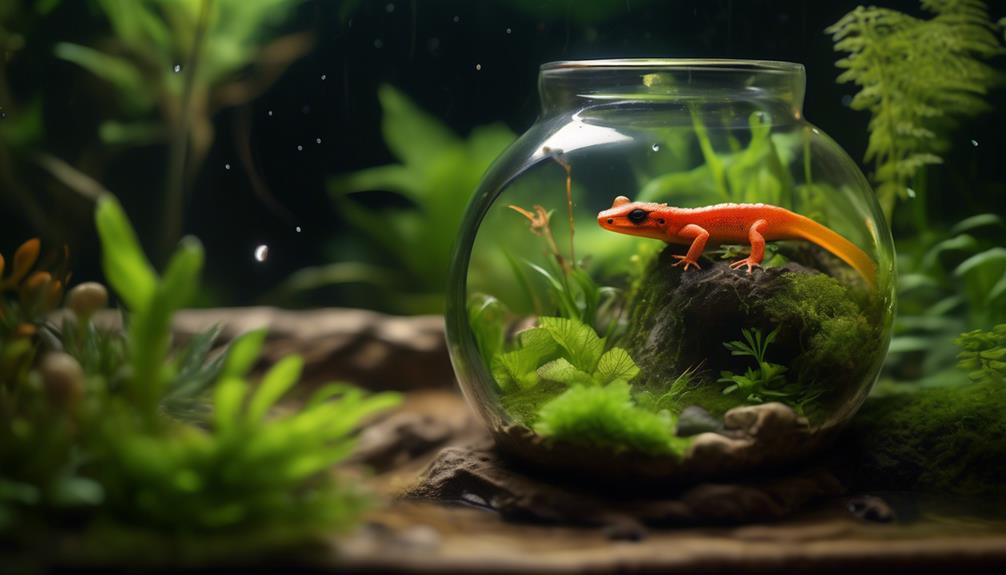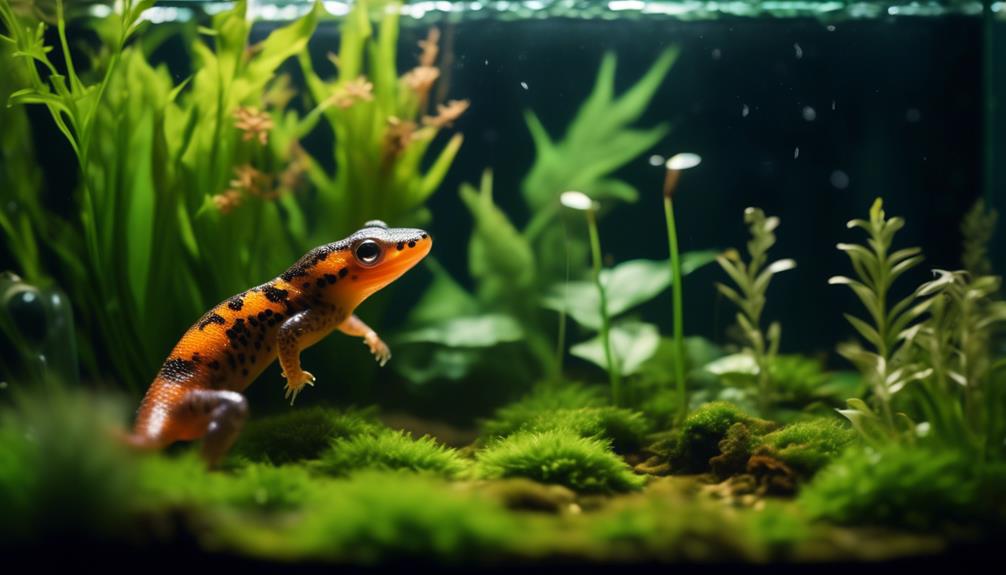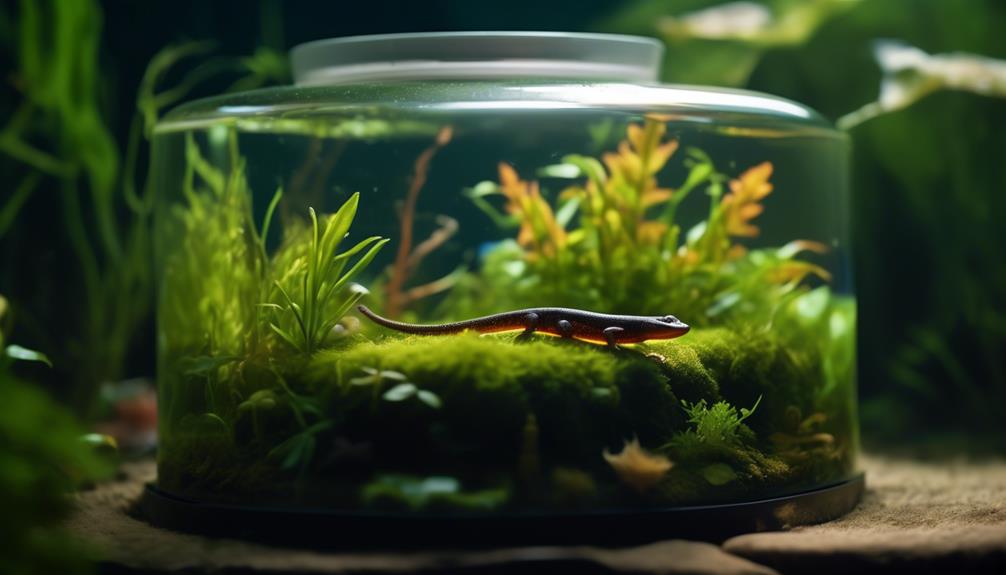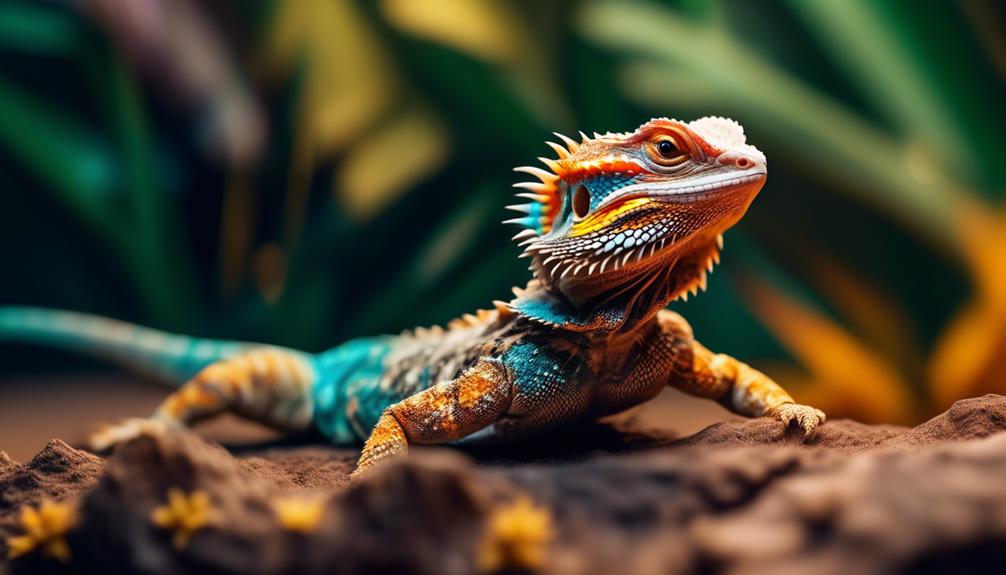Are you ready to dive into the depths of Eastern newt care?
As seasoned enthusiasts, we have charted the waters of knowledge and are eager to share our essential tips for success.
Just like a skilled captain, we will steer you through the intricate details of creating the perfect enclosure, shedding light on the significance of UVB lighting, navigating the treacherous waters of temperature and humidity requirements, and ensuring pristine water maintenance.
But that's merely the surface!
There's a world of fascinating insights awaiting you as we unravel the secrets to mastering Eastern newt care.
So, prepare to embark on this captivating journey of discovery with us.
Key Takeaways
- Eastern newts require a minimum tank size of 20L x 10W x 10H or a standard 10 gallon tank, with larger tanks preferred for better space.
- Providing UVB lighting, such as the Zoo Med Compact Fluorescent Reptisun 5.0, 26w bulb, is important for the optimal health of Eastern newts.
- The water temperature should be between 60-70°F, while the air temperature should be between 65-70°F. Accurate temperature measurement is essential.
- Maintaining humidity levels around 80% is crucial for the growth phase of Eastern newts, and misting the enclosure with a spray bottle can help achieve this.
Enclosure Requirements

When setting up an enclosure for Eastern newts, it's important to consider their specific requirements to ensure their well-being and happiness.
The enclosure size plays a crucial role in providing enough space for these amphibians. A minimum tank size of 20L x 10W x 10H or a standard 10-gallon tank is necessary, although larger tanks are preferred for better space.
Additionally, lid security is essential to prevent any escape attempts. The enclosure should have a tightly-fitting lid to ensure the newts stay safely inside their habitat. This will also help maintain the proper temperature and humidity levels within the enclosure.
UVB Lighting
To ensure the optimal health and well-being of Eastern newts, providing UVB lighting is essential. UVB lighting offers numerous benefits for reptiles, including the synthesis of vitamin D. Here are five key reasons why UVB lighting is crucial for Eastern newts:
- Vitamin D Synthesis: UVB lighting enables Eastern newts to produce and metabolize vitamin D, which is essential for calcium absorption and overall skeletal health.
- Appetite Stimulation: Exposure to UVB lighting encourages Eastern newts to eat, ensuring they receive the necessary nutrients for growth and development.
- Activity Promotion: UVB lighting stimulates Eastern newts' natural behavior and activity levels, helping to prevent lethargy and promote a healthy lifestyle.
- Skin and Eye Health: Adequate UVB lighting aids in the maintenance of healthy skin and eyes in Eastern newts, preventing issues such as dryness or infection.
- Overall Health: Providing UVB lighting for Eastern newts promotes their overall well-being, enhancing their immune system and reducing the risk of diseases.
Incorporating UVB lighting into their habitat is crucial for the optimal health and thriving of Eastern newts.
Temperature Requirements

Eastern newts have specific temperature requirements to maintain their health and well-being in captivity. As ectotherms, they rely on the temperature of their environment to regulate their body temperature.
It's crucial to provide the correct temperatures to prevent heat stress and ensure their overall health. The water temperature should be maintained between 60-70°F, while the air temperature should be kept between 65-70°F. To accurately measure these temperatures, digital thermometers should be used.
It's important to note that eastern newts are sensitive to high temperatures and can easily experience heat stress, which can be detrimental to their health. By closely monitoring and maintaining the appropriate temperature range, heat stress prevention can be achieved, ensuring the well-being of your eastern newts in captivity.
Humidity Levels
Maintaining appropriate humidity levels is crucial for the health and well-being of eastern newts in captivity, complementing the temperature requirements discussed earlier. To ensure optimal conditions, here are some essential tips:
- Humidity monitoring: Use a digital probe hygrometer to accurately measure humidity levels in the enclosure. This will help you maintain the ideal humidity of around 80%.
- Mist the enclosure: Mist the enclosure 1-2 times per day with a spray bottle to increase humidity. This will create a humid environment that simulates the natural habitat of eastern newts.
- Providing a humid retreat: It's important to provide a humid retreat for the newts, such as a resin hide or a small cork flat. This will give them a place to seek refuge and maintain their moisture levels.
- Avoid excess moisture: While high humidity is important, it's crucial to strike a balance. Avoid excessive moisture, as it can lead to the growth of harmful bacteria and fungi.
- Regular monitoring: Continuously monitor humidity levels to ensure they remain within the appropriate range. Adjust misting frequency as needed to maintain optimal conditions for your eastern newts.
Water Maintenance

We recommend installing a reliable aquarium filter to ensure the cleanliness of the water in your eastern newt's enclosure. Water quality is crucial for the health and well-being of your pet.
A good filtration system will help remove debris, excess food, and waste, keeping the water clean and clear. It's important to choose a filter that's appropriate for the size of your tank and the needs of your newt. Consider factors such as water flow rate, mechanical and biological filtration capabilities, and ease of maintenance.
Regular maintenance is also essential for optimal water quality. Perform partial water changes of 20-30% once per week to remove any accumulated toxins. Use a dechlorinator like Zoo Med Reptisafe when adding water to the tank to eliminate harmful chlorine or chloramines.
Additionally, manual scrubbing of algae buildup with a brush or magnetic glass scrubber, as well as cleaning the substrate with a siphon during water changes, will help maintain a healthy and clean environment for your eastern newt.
Frequently Asked Questions
What Is the Lifespan of an Eastern Newt?
Eastern newts have an average lifespan of 12-15 years in the wild. Breeding habits are influenced by temperature and water conditions. Understanding their natural habitat requirements is crucial for successful breeding and long-term care.
Can Eastern Newts Be Housed With Other Aquatic Species?
Yes, Eastern newts can be housed with other aquatic species, but it is important to choose compatible tank mates. Avoid aggressive or larger species that may harm or outcompete the newts for resources.
How Often Should Eastern Newts Be Fed and What Should Their Diet Consist Of?
Eastern newts should be fed daily or every other day, depending on their age and size. Their diet consists of live or frozen foods like bloodworms, brine shrimp, and small insects. Providing a varied diet is important for their overall health.
Are Eastern Newts Considered a Beginner-Friendly Pet?
Yes, Eastern newts are considered beginner-friendly pets. They have relatively simple care requirements and are hardy. However, it's important to research and understand their specific needs before getting one.
Do Eastern Newts Require Any Special Care During Their Breeding Season?
During their breeding season, Eastern newts exhibit fascinating reproductive behavior. They engage in courtship rituals, with the males performing elaborate displays to attract females. Breeding habits include the deposition of eggs in aquatic environments and the subsequent hatching of larvae.
Conclusion
In conclusion, mastering Eastern newt care is an exciting journey that requires attention to detail and the right knowledge. By following the tips and tricks provided in this article, you'll be able to create the perfect enclosure, provide the necessary UVB lighting, maintain the ideal temperature and humidity levels, and ensure proper water maintenance.
With these essential tips, you'll be well-equipped to provide exceptional care for your Eastern newts and witness their success thrive like never before. Dive in and unlock the secrets to their well-being today!


